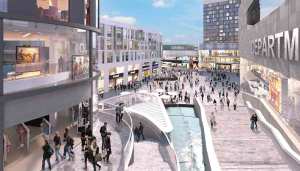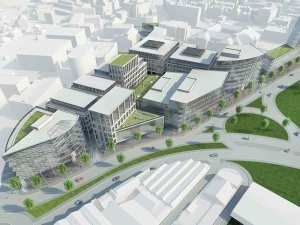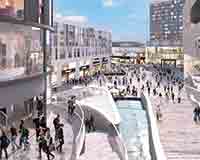 The people of Sheffield have had their patience tested in recent times. From shopping malls to office schemes, ambitious plans to rejuvenate a neglected city centre have fallen by the wayside. Then, on 27 March, two announcements signalled that Sheffield’s regeneration drive may finally be back on track.
The people of Sheffield have had their patience tested in recent times. From shopping malls to office schemes, ambitious plans to rejuvenate a neglected city centre have fallen by the wayside. Then, on 27 March, two announcements signalled that Sheffield’s regeneration drive may finally be back on track.
First to emerge was a £480m plan to give the city a new retail quarter. The city council’s masterplan comprises 900,000 sq ft of mixed-use space. Up to 700,000 sq ft is earmarked for retail, while more than 200,000 sq ft will be set aside for residential and office space.
The plans are based on a streetscape shopping district incorporating existing pitches such as The Moor, Fargate and Devonshire Quarter into an integrated circuit.
The council hopes to improve the viability of the project through the Tax Incremental Finance (TIF) scheme – a mechanism allowing the council to borrow against projected business rates from new development – and has already received enquiries from more than 20 parties.
It intends to name a development partner by April next year, with the majority of the quarter set for completion in 2019.
 The city has been waiting to hear how Sheffield’s retail future can be salvaged since 2013, when Hammerson abandoned its 680,000 sq ft Sevenstone scheme.
The city has been waiting to hear how Sheffield’s retail future can be salvaged since 2013, when Hammerson abandoned its 680,000 sq ft Sevenstone scheme.
“We’ve been busy doing market testing to find the best proposal for the city and have put together one contiguous land holding so that a development partner only has us to deal with,” says Sheffield city council’s executive director, Simon Green.
Green insists retailers had significant input into the design and hopes the quarter will help recapture £90m of annual spend lost to rival retail centres.
As the UK’s sixth-largest city, Sheffield has consistently punched below its weight as a retail destination, largely because of lack of investment in modern space. It languishes in 19th place in CACI’s Retail Footprint and 37th in the Experian Retail Index.
According to the council’s own research, Sheffield has 32% less mid-market retail than the benchmark average of comparative city centres and 85% less upper mid-market retail. The shortfall is causing significant leakage of retail spend to Manchester and Leeds – and to the colossal Meadowhall, situated just three miles outside the city centre.
“Sheffield desperately needs quality retail floorspace and it can’t afford further delays,” says Savills director Steve Henderson. “Uncertainty has prevented retailers from committing to the city. Demand would be strong for the right type of development, both from new names and those based in Meadowhall who would like an additional store in the city centre.”
The challenge is forming a workable partnership between council and developer so we don’t see yet another marriage break-up. “The scheme has to be deliverable and it may be that they have to work with different developers on different elements of the project,” says Henderson.
It is a given that, if development is to be viable, John Lewis must be persuaded to sit at the heart of the quarter – either taking new space, or refurbishing its existing city centre store. Yet beyond that, the market is likely to have its own ideas about how the new quarter should be configured.
 “There is more than one way to cook an egg and the council will need to be broad-minded,” says John Crowther, chair of the Sheffield Retail Development Group (SRDG). “There is plenty of demand for the right solution, but we have done our own assessment of demand and look forward to presenting competing plans.”
“There is more than one way to cook an egg and the council will need to be broad-minded,” says John Crowther, chair of the Sheffield Retail Development Group (SRDG). “There is plenty of demand for the right solution, but we have done our own assessment of demand and look forward to presenting competing plans.”
Crowther, a former chief executive of Vickers Defence Systems, would not go into detail about his plans, but in December SRDG told local press it had lined up £500m of funding to deliver its own 650,000 sq ft city centre retail quarter by 2018. It said the plans, supported by architect Chapman Taylor and property consultancy Central Retail, would incorporate retail, leisure, office and residential.
Central Retail’s Simon Lyons says: “I think a scheme offering around 600,000 sq ft of retail would be more realistic, with a major anchor, two or three big MSUs and around 75 retail units. Sheffield needs a scheme it can get off the ground because it simply can’t afford to make another mistake. The city centre has been losing out to Meadowhall for the past 25 years and it’s time to deliver – or there is a danger of missing this market cycle.”
New office district to raise the bar
Plans have been announced to provide Sheffield with a £250m office district. Set just outside the city ring road, West Bar Square is designed to provide the floorplates required by inward investors.
Sheffield city council has signed agreements with Urbo Regeneration to breathe new life into a project that has sat on the sidelines since developer Castlemore went into administration in 2009. The plans will deliver 600,000 sq ft of offices with floorplates of up to 20,000 sq ft, together with 200 homes, shops and leisure. Rather than the three tall towers originally proposed by Castlemore, Urbo will deliver low-rise buildings surrounding a new square, linking Sheffield’s Cathedral Quarter to the Riverside.
“We already owned land in the area and have been working with the council to provide inward investors with large floorplates right on the edge of the city centre,” says Urbo’s managing director, Peter Swallow.
Site clearance will begin shortly and Swallow hopes to submit an application to renew outline planning consent in the summer. Subject to consent and an office prelet, construction should start towards the end of 2016, with a 12- to 18-month delivery.
Swallow views the new office district as an extension to Wilson Bowden’s nine-acre development Riverside Exchange, which attracted the likes of Irwin Mitchell and the Home Office.
“The plans are ambitious but credible,” argues Stephen Hodgson, partner at Knight Frank, which has been appointed joint agent alongside BNP Paribas. “There are national requirements for back-office buildings with big floorplates and it is likely to attract occupiers such as call centres, financial services and government.”
Quoting rents at around £22 per sq ft, West Bar will be seen as a far more affordable location, compared with other regional cities.
Financial support
Comparatively low rents and rising construction costs have meant new office development within Sheffield has been viable only with financial assistance. Urbo’s Swallow is hoping West Bar will attract big covenant occupiers but won’t rule out needing to dip into the public purse.
West Bar may need to follow the example set by 3 St Paul’s Place, Sheffield’s first post-recession speculative office scheme. The 80,000 sq ft building by CTP and Development Securities is under construction and has a grant from the European Regional Development Fund (ERDF) and loan assistance from the Sheffield City Region Jessica Fund. In addition, Sheffield council has agreed to buy the building at a discounted rate, if it isn’t sold 12 months after completion.
Agents are confident that will not be necessary. The first chunk of 13,000 sq ft is about to be put under offer and West Bar is likely to be sold at a much higher price to the private sector.
“But it is a bold step by the council,” says DTZ’s Tim Cameron-Jones. “When we did the appraisal in 2013, the scheme was on the periphery of being viable, but it was very difficult to get funding for speculative development.”
As investor appetite increases, Sheffield’s office market may soon be able to stand on its own two feet.











